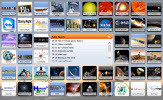Welcome to this issue of
Qué tal in the Current Skies
Here you will find useful observing information about the visible planets,
our Moon and other moons, the Sun, as well as various 'things' celestial.
Among these web pages you will find monthly star maps for either the northern or southern hemisphere that are suitable for printout.
Animated images are utilized to illustrate celestial motions such as orbital motions of the planets, and other solar orbiting objects,
or apparent and real motions along the ecliptic and the local horizon. Regular features include plotting the monthly positions of the
visible planets using heliocentric coordinates; following moon phases; conjunctions; the sun's apparent motion and the Earth's real
motion along the ecliptic.
Scroll down for more web site information, resources, and a link to the previous month issue.
June 2019
This month the inner planet Mercury and outer terrestrial planet Mars will be the evening planets visible over the western horizon at sunset local time. Watch for a close conjunction between these two planets on the 18th. Shift the planet viewing tp the morning skies and you will find two of the 'giant' outer planets, Saturn and Jupiter, over the southeastern horizon in the hours before the Sun rises. Inner planet Venus is also in the pre-sunrise skies, visible but low over the eastern horizon. The closest Dwarf Planet, Ceres, is also visible in the morning skies but requires optical assistance to be seen.
Click here for the month at a glance calendar.

Mercury will be visible most of the month in the evening skies as the innermost planet moves toward its greatest eastern elongation on the 23rd. Mercury has a conjunction with the Moon on the 4th and a close conjunction with Mars on the 18th.
Venus is visible but low over the eastern horizon this month as it steadily moves toward superior conjunction in the coming months.
Mars is still visible but is low over the western horizon at sunset. This plus its steadily decreasing apparent magnitude make Mars more difficult to see.
Dwarf Planet Ceres is about 10-15o to the west from Jupiter and the reddish star Antares in Scorpius the Scorpion. However at nearly 7th magnitude Ceres will be best visible with larger telescopes or time exposure pictures with a camera.
Jupiter reaches opposition on the 10th and thus will be visible all night, rising at sunset and setting at sunrise local time. Jupiter will have a close conjunction with the waxing gibbous Moon on the 16th.
Saturn continues rising earlier each evening as it moves toward opposition in July. Saturn is basically visible all night and has a close conjunction with the waning gibbous Moon on the 19th.
-.-. .-.. . .- .-. ... -.- .. . ...
Click on this link to read the Previous Issue of Qué tal? in the Current Skies
Did you know? Qué tal in the Current Skies was selected by Sky & Telescope Magazine as one of the "Seven Best of the Web" personal web sites.
| June Sky Calendar | ||||
|
01. Waning Crescent Moon Near Venus 03. New Moon 04. Waxing Crescent Moon Near Mercury 05. Waxing Crescent Moon Near Mars Moon at Ascending Node 06. Waxing Crescent Moon Near Beehive Cluster (M-44) 07. Moon at Perigee: 228,977 miles (368,504 km) 08. Waxing Crescent Moon Near Regulus 09. Venus Near the Pleiades |
|
10. First Quarter Moon Jupiter at Opposition 14. Waxing Gibbous Moon West of Ceres 15. Waxing Gibbous Moon East of Ceres 16. Waxing Gibbous Moon Near Jupiter 17. Full Moon Mercury - Mars Close Conjunction 18.Waning Gibbous Moon Near Saturn 19. Moon at Descending Node |
|
21. The Sun does not enter Cancer the Crab June Solstice 22. The Sun enters Gemini the Twins 23. Moon at Apogee: miles 251,374 miles (404,548 km) Mercury at Greatest Elong: 25.2°E 25. Last Quarter Moon 27. Waning Crescent Moon Near Uranus 28. Waning Crescent Moon Near Aldebaran 30. Thin waning Crescent Moon Near Pleides and Hyades |
 Above the Solar System at 10 day Intervals
Above the Solar System at 10 day Intervals

Planet cordinate data for the visible planets and the Sun at 10-day intervals for this month.
Click here to see the
web page showing this information, and also for a larger and easier to read version of the above graphic.
















 Lee's Summit, MO
Lee's Summit, MO 